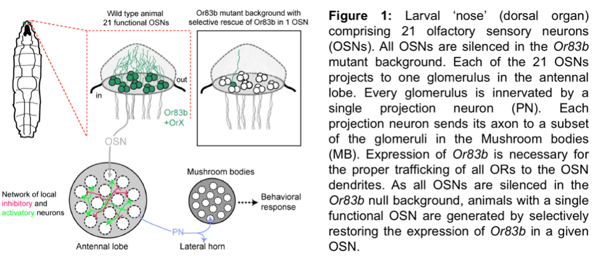 Peripheral representation of odour stimuli
Peripheral representation of odour stimuli
(Mariana Lopez-Matas, Moraea Philipps, Julia Riedl, Aljoscha Schulze)
The larval ‘nose’ is composed of 21 olfactory sensory neurons (OSNs) expressing typically one type of odorant receptors along with a ubiquitously expressed co-receptor (Or83b) (Fig 1). Previously, we have demonstrated that individual odorant receptors have overlapping, yet distinct, ligand tuning properties (Asahina, Louis et al., 2009). Accordingly, each OSN can be viewed as distinct information channel to the olfactory system. We have also shown that the information transmitted by a single functional OSN is sufficient for the detection of minute changes in odour intensity. Performing electrophysiological recordings on single OSNs, we are characterizing how odour intensity and quality is represented in the activity of single OSNs.
Whether one type of odorant receptor alone is capable of encoding the quality of an odour remains an open question in the larva. We have undertaken to disentangle the contribution of single OSNs to the representation of static and dynamic odour stimuli (Fig 1). In Pavlovian conditioning experiments, we found evidence that a single functional OSN is sufficient to mediate odour quality discrimination. This finding highlights the surprisingly high coding potential of single sensory neurons.
Odours are represented by dynamical patterns of neural activity transmitted from the OSNs to higher brain centres (Fig 1). We have devised a novel preparation to carry out extracellular and intracellular recordings from the peripheral olfactory system. Using this technique, we have begun to compare the activity elicited in identified OSNs. Our current goal is to explain the ability (or inability) of larvae with a single functional OSN to discriminate between distinct odours. By taking advantage of new odour delivery systems that allow us to generate temporal changes in odour concentration during electrophysiological recordings, we are now in position to study the encoding of naturalistic odour stimuli in the peripheral olfactory system.
We are also interested in characterizing how odour-specific activity patterns evolve across different layers of the olfactory system. Functional imaging is applied to monitor the activity in neuronal ensembles. By expressing genetically encoded calcium sensors (GCaMP) in targeted neurons, we seek to establish precise correlations between sensory input and circuit activity. Our goal is to clarify the role of local inhibitory interneurons in the antennal lobe (Fig 1), a circuit that is thought to achieve gain control and decorrelation. Our long-term goal is to extend this analysis to motor control, and to propose a model for how ethologically relevant sensory input (e.g., increase or decrease in the concentration of a food odour) induce specific behavioural output (e.g., orientation towards the odour source).

